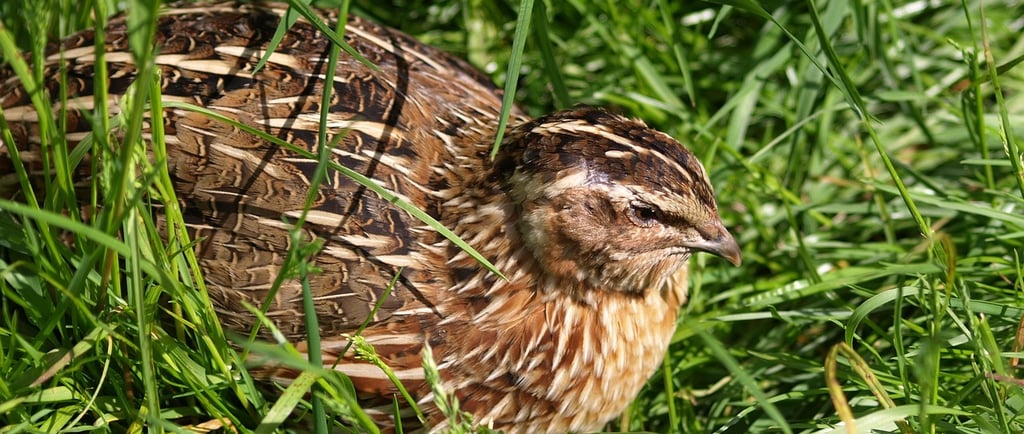Revolutionizing Poultry: Detailed Guide to Japanese Quail Farming in Dimapur, Nagaland
Discover how Japanese Quail farming is set to transform the poultry landscape in Dimapur, Nagaland. This detailed blog post explores a pioneering project aiming to produce 60,000 birds and 120,000 eggs annually, using sustainable deep litter systems. Dive into the strategic planning, financial insights, and operational frameworks that make this venture a promising model for success in regional poultry farming. Learn about the market dynamics, growth potential, and economic benefits of raising Japanese Quails in one of India’s vibrant northeastern states.
ORGANIC AGRO-LIVESTOCK FARMING
Dr. Emmanuel L Yanthan (MS OB-GYN)
5/13/20244 min read


Detailed Guide to Japanese Quail Farming in Dimapur, Nagaland.
Quail farming can be a profitable venture when approached with the right knowledge and resources. Here's a comprehensive guide covering essential aspects of commercial quail farming:
1. Species Selection
Coturnix Quail (Japanese Quail): Most common for meat and eggs. They mature quickly, start laying at about 6-7 weeks of age, and are hardy.
Bobwhite Quail: Popular in North America for hunting stock and meat. They mature in about 16 weeks.
California and King Quail: Used mostly for ornamental purposes but can also be used for meat.
2. Housing and Equipment
Housing: Quails require secure housing to protect them from predators and harsh weather. The housing should be well-ventilated but draft-free, with a space allowance of 1 square foot per 5-6 quails in a caged system.
Cages: Commercial quail farming often uses tiered cage systems to save space and simplify management.
Feeding Troughs and Waterers: Must be accessible and designed to minimize waste.
3. Feeding
Diet: High-protein feed (around 24-30% protein content) is crucial, especially for growing chicks and laying quails. Adult quails can be maintained on 18-20% protein.
Regularity: Feed should be provided in a consistent manner to maintain health and productivity. Automatic feeding systems can help in larger operations.
4. Breeding
Age for Breeding: Quails are sexually mature by about 6 weeks, but it's optimal to start breeding at 8-10 weeks for healthier offspring.
Management: Keeping a ratio of about one male to every three to five females can ensure effective breeding.
5. Health Management
Sanitation: Regular cleaning and disinfecting of the environment are mandatory to prevent disease.
Common Diseases: Look out for quail bronchitis, coccidiosis, and avian influenza. Preventative measures include vaccinations and maintaining strict biosecurity.
6. Egg Production
Egg Handling: Eggs should be collected at least twice a day, and stored in a cool, dry place before incubation or sale.
Incubation: Incubation period for quail eggs is about 17-18 days. Proper incubator settings are crucial for high hatch rates.
Detailed project report for establishing a Japanese Quail farming operation in Dimapur, Nagaland, focusing on both egg and meat production:
1. Executive Summary
Objective: To establish a commercial Japanese quail farm aimed at producing 60,000 birds for meat and 120,000 eggs annually using the deep litter system.
Location: A strategically selected site in Dimapur, Nagaland, offering access to local markets and distribution channels.
Investment Highlight: The project is designed for high yield with a focus on sustainable farming practices, aiming to achieve significant returns on investment through direct sales and contractual agreements with local businesses.
2. Business Description
Farm Structure: The farm will operate as a private limited company with the intent to scale operations and possibly integrate vertically in the future.
Market Edge: Leveraging the growing demand for alternative protein sources and organic eggs within regional markets.
3. Market Analysis
Target Market: Local retailers, restaurants, and direct consumer sales through farmer's markets and online platforms. Potential to expand to nearby urban centers as operations stabilize.
Competition: Detailed analysis of other poultry and quail farms within the region, emphasizing our advantages in product quality and consistency.
Pricing and Sales Strategy: Competitive pricing strategy set at INR 80 per adult bird and INR 5 per egg, aiming to undercut market rates slightly while ensuring profitability.
4. Operations Plan
Breeding Program: Implementation of a selective breeding program to maintain a healthy and productive quail population, with continuous monitoring of genetic diversity.
Health and Biosecurity Measures: Regular health checks, vaccination programs, and strict biosecurity measures to prevent disease outbreaks.
Staff Requirements: Recruitment of experienced farm managers, technicians, and casual labor for daily operations, estimated at 15 full-time employees.
5. Infrastructure Development
Housing: Construction of deep litter housing over 10,000 square feet, designed to facilitate easy cleaning and maintenance.
Feeding and Watering Systems: Installation of cost-effective and efficient systems for feeding and automatic water dispensers to ensure adequate nutrition and hydration.
Storage and Processing Facilities: Facilities for the safe storage of feed and processing of eggs and meat to meet health regulations.
6. Financial Projections
Capital Investment:
Land and Infrastructure: Estimated at INR 3,000,000 for purchase and development.
Equipment and Initial Stock: INR 600,000 for breeding stock and essential equipment.
Operating Expenses:
Feed: Approximately INR 10,784,830 annually (adjusted for the scale of 60,000 birds).
Labor and Utilities: Estimated annual cost of INR 700,000.
Revenue Forecast:
Meat Sales: 60,000 birds/year at INR 80 each = INR 4,800,000.
Egg Sales: 120,000 eggs/year at INR 5 each = INR 600,000.
Total Annual Revenue: INR 5,400,000.
Projected Net Profit: After subtracting annual operating costs and initial setup costs amortized over the first year, a projected net profit of INR 1,915,170. Net profit is expected to increase exponentially from Second Year onwards, with annual profit expected to cross 30 lakhs.
7. Risk Management
Market Volatility: Diverse marketing strategies and the establishment of supply contracts to mitigate price fluctuations.
Disease Control: Implementation of an advanced health management system and training for all personnel in biosecurity.
8. Implementation Timeline
Phase 1 - Setup: Land acquisition and construction (0-6 months).
Phase 2 - Operation Commencement: Stocking and start of production (6-12 months).
Phase 3 - Full Capacity Production: Achieving full operational capacity and market penetration (12-18 months).
9. Appendices
Detailed Cost Breakdowns: Including quotations for construction, equipment, and feed.
Legal and Regulatory Documentation: Copies of permits and health compliance certificates.
CVs of Key Personnel: Highlighting industry experience and qualifications.
This enhanced project report provides a clear, detailed roadmap for establishing a successful Japanese Quail farming operation in Dimapur, with strategic insights into financial planning, operational setup, and risk management. It is designed to secure funding and ensure long-term sustainability.
